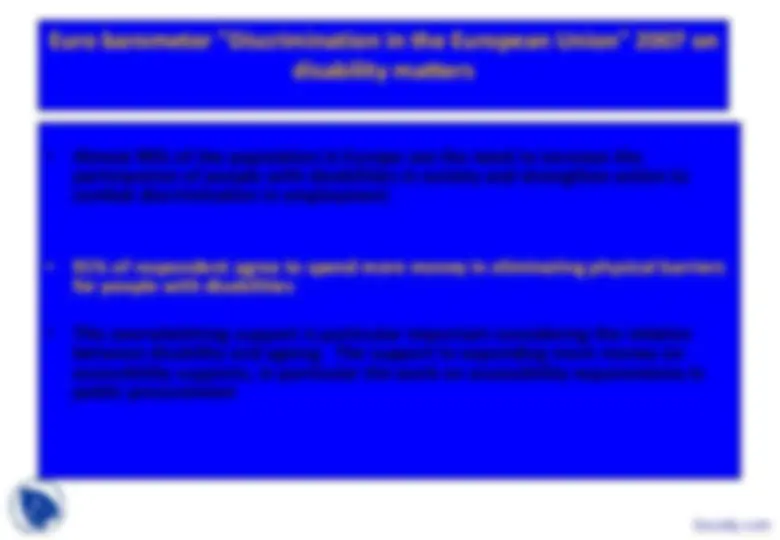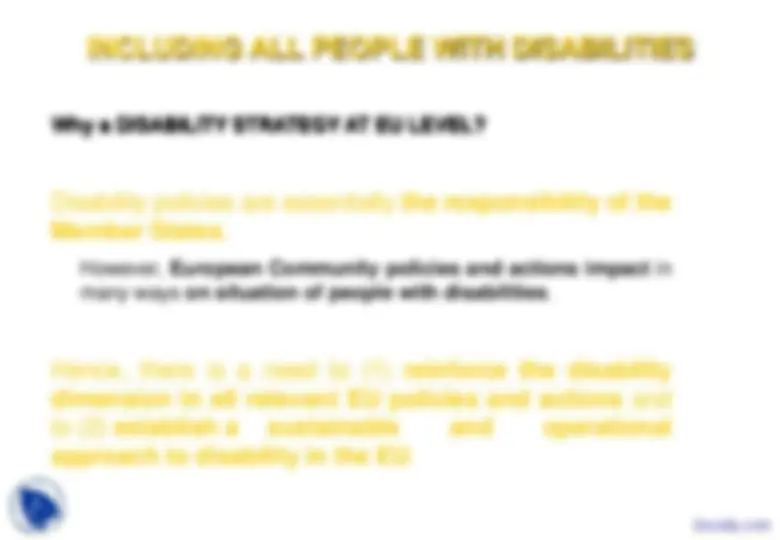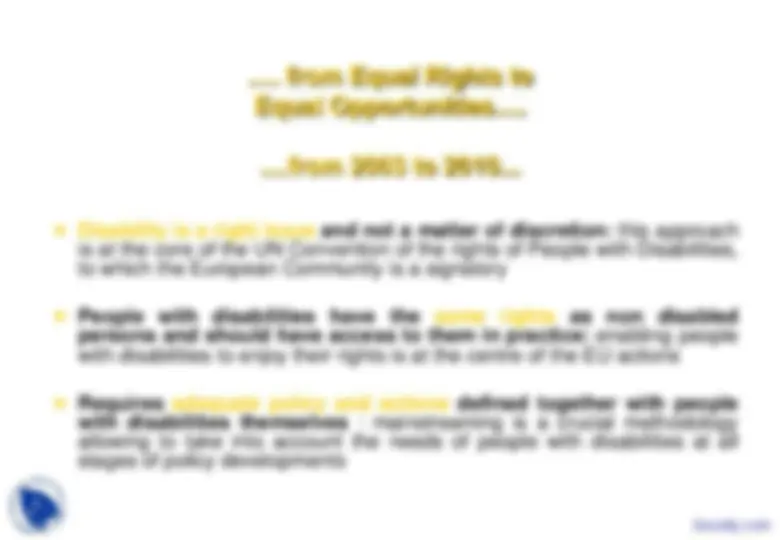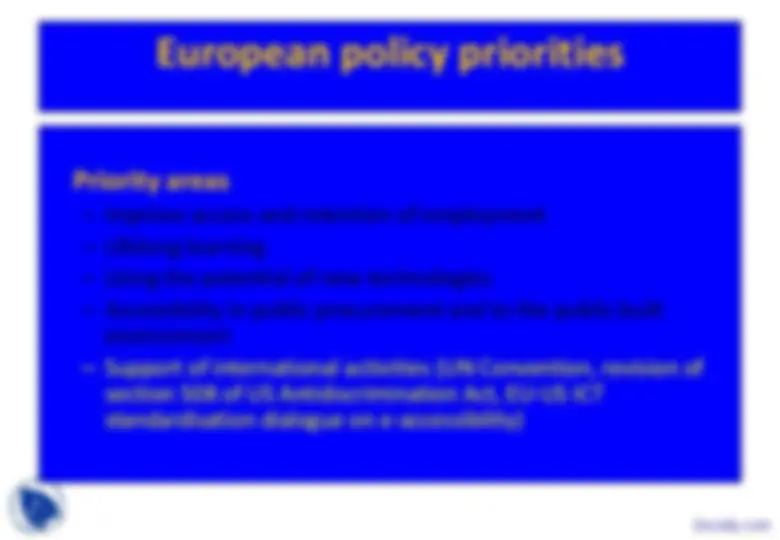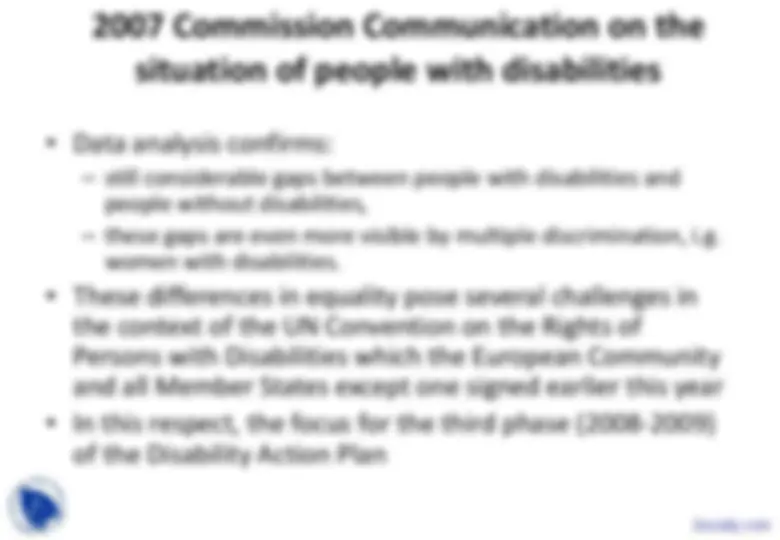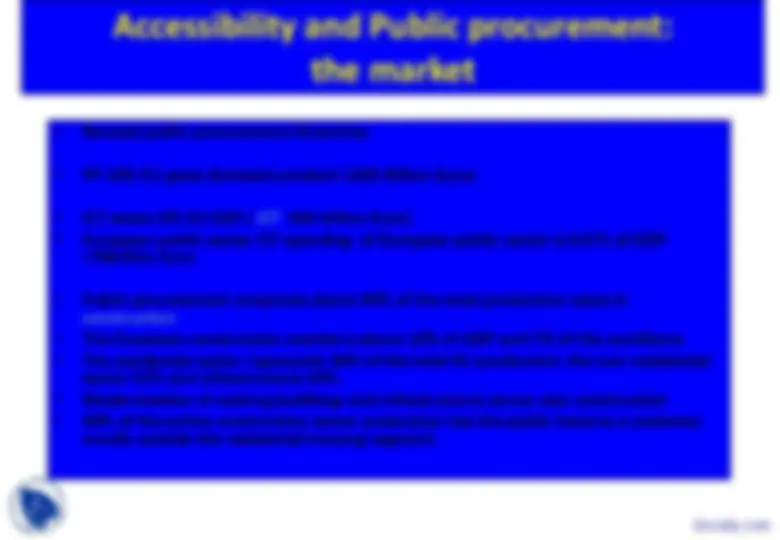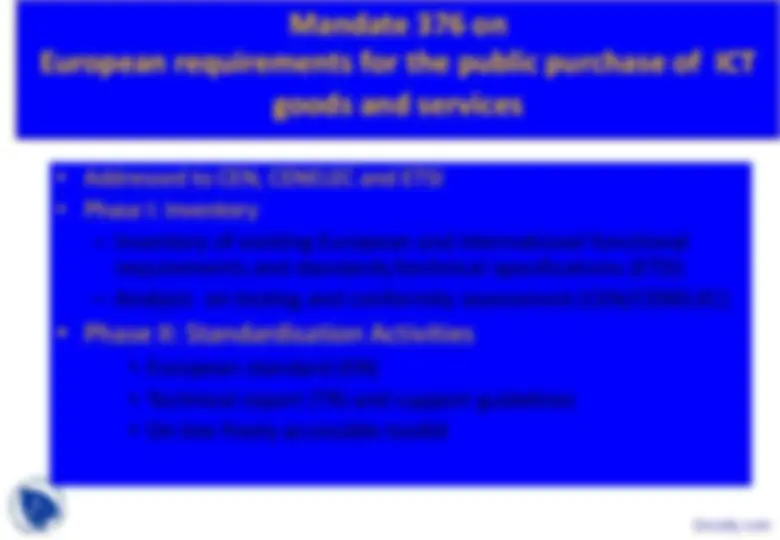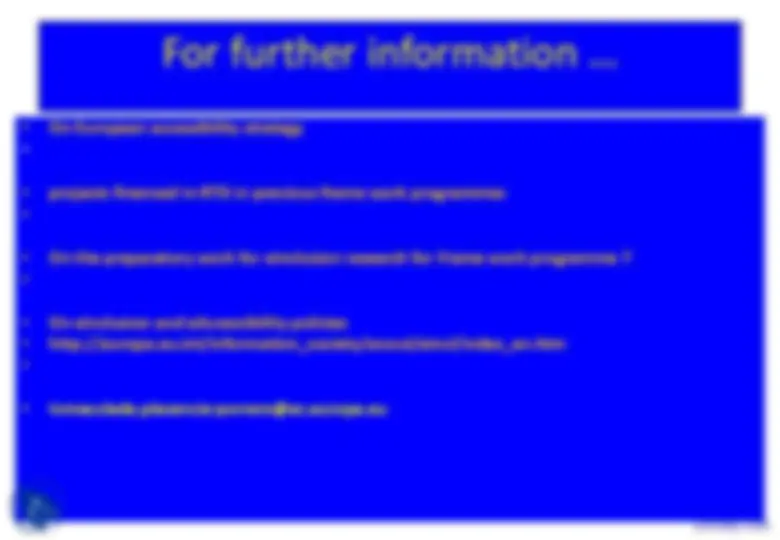Download European Disability Action Plan and eAccessibility: Statistics and Policies and more Slides Introduction to Sociology in PDF only on Docsity!
The European Disability Action Plan and e-
Accessibility standardisation
KEY FIGURES
44.6 MILLION in Europe – one in six – persons aged between 16 and 64 report
a long standing health problem or disability
16% of the overall EU working age population
63% OF PEOPLE WITH DISABILITIES ARE OLDER THAN 45. Nearly
30% of people in the age group 55-64 report a disability. The incidence of disability
will increase as the EU population gets older.
50% OF DISABLED PERSONS ARE EMPLOYED COMPARED TO
68% OF NON DISABLED
Only 15.9% of working disabled persons are provided with some
assistance to work. At the same time, 43.7% of respondents believe they
could work if they were given adequate assistance.
INCLUDING ALL PEOPLE WITH DISABILITIES
Why a DISABILITY STRATEGY AT EU LEVEL?
Disability policies are essentially the responsibility of the
Member States.
However, European Community policies and actions impact in
many ways on situation of people with disabilities.
Hence, there is a need to (1) reinforce the disability
dimension in all relevant EU policies and actions and
to (2) establish a sustainable and operational
approach to disability in the EU.
…. from Equal Rights to
Equal Opportunities….
....from 2003 to 2010...
Disability is a right issue and not a matter of discretion: this approach
is at the core of the UN Convention of the rights of People with Disabilities,
to which the European Community is a signatory
People with disabilities have the same rights as non disabled
persons and should have access to them in practice: enabling people
with disabilities to enjoy their rights is at the centre of the EU actions
Requires adequate policy and actions defined together with people
with disabilities themselves : mainstreaming is a crucial methodology
allowing to take into account the needs of people with disabilities at all
stages of policy developments
DISABILITY ACTION PLAN
SET-UP MONITORING & FOLLOW-UP
• THROUGH INSTITUTIONAL FRAMEWORK
- Disability High Level Group meetings , comprising MS and third sector representatives.
- Disability Inter-Service Group meetings , comprising civil servants from different directorates general.
- Dialogue with the EP , monitoring of Parliamentary Inter-Service group activities
- Dialogue with CoR and EESC
• THROUGH OTHER MEANS
- Dialogue with Social Partners and other relevant stakeholders
- Establishment of the Action Plan scoreboard allowing continual monitoring of the implementation process
- Through eventual meetings of MS disability ministers
- Academic network of disability experts
European policy priorities
Priority areas
- Improve access and retention of employment
- Lifelong learning
- Using the potential of new technologies
- Accessibility in public procurement and to the public built
environment
- Support of international activities (UN Convention, revision of
section 508 of US Antidiscrimination Act, EU-US ICT
standardisation dialogue on e-accessibility)
2007 Commission Communication on the
situation of people with disabilities
- Data analysis confirms:
- still considerable gaps between people with disabilities and
people without disabilities,
- these gaps are even more visible by multiple discrimination, i.g.
women with disabilities.
- These differences in equality pose several challenges in
the context of the UN Convention on the Rights of
Persons with Disabilities which the European Community
and all Member States except one signed earlier this year
- In this respect, the focus for the third phase (2008-2009)
of the Disability Action Plan
2007 Commission Communication on the
situation of people with disabilities
- The Communication identifies 2 areas with 5 priorities:
- Actions for inclusive participation through accessibility:
- Fostering accessibility of the labour market
- Boosting accessibility of goods, services and infrastructures,
addressing transport ICT and built environment.
- Consolidating the Commission’s analytical capacity to support
accessibility
- Actions towards full enjoyment of fundamental rights:
- Facilitating the implementation of the UN Convention
- Complementing the Community legislative framework of
protection against discrimination
Accessibility and Public procurement:
the market
- Revised public procurement Directives
- PP 16% EU gross domestic product 1500 Billion Euros
- ICT sector 6% EU GDP ( ICT 594 billion Euro)
- European public sector ICT spending of European public sector is 0,8 % of GDP =76billion Euro
- Public procurement comprises about 40% of the total production value in construction
- The European construction market is about 10% of GDP and 7% of the workforce.
- The residential sector represents 46% of the total EU production, the non-residential sector 31% and infrastructure 23%.
- Modernisation of existing buildings and infrastructure versus new construction
- 40% of the entire construction sector production has the public hand as a customer, mostly outside the residential housing segment
Public Procurement Directives
- The preambles to the revised Directives (paragraph 29 of Directive 2004/18/EC and paragraph 42 of Directive 2004/17/EC) now state that: “Contracting authorities should, whenever possible, lay down technical specifications so as to take into account accessibility criteria for people with disabilities or design for all users.”
- In addition, the specific Articles on technical specifications (Article 23, Paragraph 1 of Directive 2004/18/EC and Article 34, Paragraph 1 of Directive 2004/17/EC) now state that: “Whenever possible [these] technical specifications should be defined so as to take into account accessibility criteria for people with disabilities or design for all users.”
- Award phase…(art 53)
the criteria on which the contracting authorities shall base the award of public contracts shall either: (a) when the awards is made to the tender most economically advantageous from the point of view of the contracting authority, various criteria linked to the subject matter of the public contract in question, for example quality, price, technical merit, aesthetic and functional characteristics, environmental characteristics,…. (b) the lowest price
Mandate 420 on Accessibility of the Built
Environment
- Addressed to CEN, CENELEC and ETSI
- Standards for addressing accessibility of the built environment in the context of
public procurement.
- Covering:
- Public buildings, public places, parkings, roads, schools, hospitals, sport
facilities, etc
- Transport facilities such as airports, train/coach stations, ports, etc
- Inventory of functional requirements and technical specifications
- Addressing the wide spectrum of people with different impairments of all ages
and age-related limitations
- In coordination with Mandate M 376 (Accessibility issues in ICT products and
services for public procurement)
THANK YOU VERY MUCH FOR YOUR
ATTENTION!

